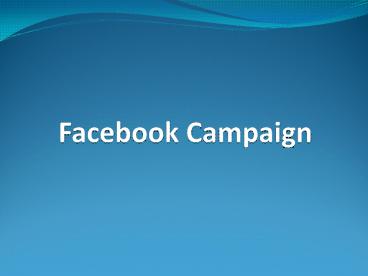How To Create a Successful Facebook Campaign - PowerPoint PPT Presentation
Title: How To Create a Successful Facebook Campaign
1
Facebook Campaign
2
INTRODUCTION
- The social media giant
offers an easy way for even the smallest
companies to quickly start a targeted ad
campaign, displaying business content to Facebook
users while they browse the site. - These campaigns are
- easier to monitor than complex
- pay-per-click search engine
- marketing because they
- require much less day-to-day
- tinkering. They also are less
- expensive than traditional
- media ad buys.
3
How to Create a Successful Facebook Campaign
- Log into your personal Facebook account
- To get started, log into Facebook and
- go to the page called Advertise on
- Facebook by clicking Create an Ad in the
- dropdown menu next to the Home button.
- This is in the upper right-hand corner of
- the main Facebook news feed screen.
4
- Decide what to advertise
- Next, Facebook wants to know what your ad should
link to. You can send users to a specific
website, such as a company blog. You also can
direct users to a company Facebook page or
promote other pages you or your business has
created on Facebook, such as events or places.
5
- Pick an advertising goal
- Once you've selected where your ad should link
to, decide what you want to accomplish. If you
want to build your social media presence by
driving fans to a Facebook page, select Get More
Likes. If you want to promote specific content on
Facebook such as a blog post, select Promote Page
Posts. - If you want to drive traffic to a website, click
See Advanced Options. All these options are worth
experimenting with, but for this demo we will
focus on advertising a website.
6
- Design the ad
- Facebook ads consist of a simple 25-character
headline and a 90-character description, plus a
thumbnail photograph. Facebook automatically
suggests these, but it's usually better to
rewrite them for your intended audience. These
can be updated in real-time, so don't be afraid
of trial and error. - The site displays images at 100 by 72
- pixels, so be sure to use a photo that
- will still be clear even when it's
- displayed in a smaller format.
- Facebook recommends your image
- be at least this size, although the site
- automatically resizes images for you.
7
- Target the ad
- You can narrow your ad's audience by targeting
specific users. You can micro-target by location
down to specific zip codes, then by age, gender
and interests. In advanced options, you can
segment by relationship status, languages spoken,
college attended, workplace or just your own
fans. By a process of trial and error, you can
whittle down your audience from Facebook's
roughly 167 million users in the U.S. to as few
as 20 people, if your marketing goal is to target
specific decision-makers.
8
- Set name, pricing and schedule
- Next, it's time to name your campaign, and then
set your budget and schedule. The name should be
distinct, perhaps something related to whom you
are targeting. A simple descriptor, such as
"college grads," can be effective as long as it
helps keep you organized. - Then, tell Facebook how much money
- you are willing to spend. This can either
- be a daily budget or a lump sum of
- total spending while the ad runs.
- Payment is either per click -- you pay
- every time someone clicks your ad
- or per thousand impressions you
- pay every time one thousand people
- see the ad.
9
- Pay for the ad
- After submitting your first ad, Facebook will
prompt you for payment information -- credit
card, direct debit, PayPal or a Facebook Ad
coupon. Billing is monthly. Facebook can hold
your ad, usually for about a day, so it can
approve its content.
10
- Monitor your campaign
- Now that your campaign is up and running, you'll
want to follow its progress by using the Ads
Manager tool, accessed from the left-hand side of
your personal Facebook account. The ads manager
shows detailed information about your campaigns,
including budget, spending and schedule.
11
- Generate a report
- You can export reports from the Reports tab in
the ads manager. These are spreadsheets or HTML
files that can be used to assess and compare ads.
This critical function provides intricate data
that offers enterprise-level insight into an ad
campaign, such as the demographics of people who
are clicking on your ads or the amount of time
between when a user clicks on an ad and likes a
page.
12
- Manage your ads and tweak as you go
- If an ad is underperforming, change its
attributes by selecting the campaign it belongs
to and then clicking on the specific ad. You can
edit the text, increase or decrease your bid, or
adjust the target audience. - You also can use your successful
- ads as templates by clicking,
- Create a Similar Ad in the editor.
- This will launch a new Create
- an Adpage with settings
- pre-selected.
13
Thank you































